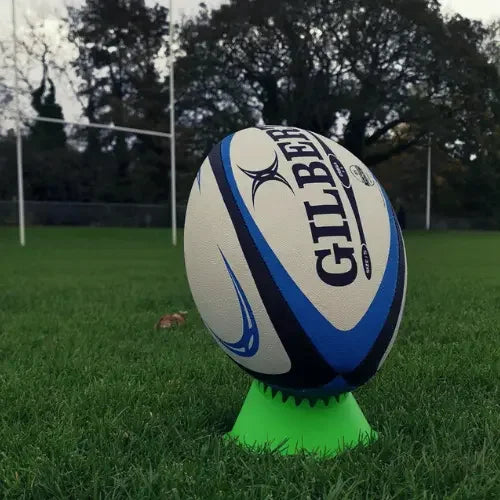Rugby Pitch Dimensions and Markings for Rugby Union
Mastering the dimensions and markings of rugby pitches can be challenging, especially for newcomers to the sport.
With a wide range of acceptable dimensions and various lines on the field, it's important to understand how they relate to the rules of the game.
In this comprehensive guide for The Rugbystuff Clubhouse, we will delve into the details of rugby pitch dimensions and markings, providing you with a clear understanding of these fundamental aspects.

Dimensions of the Rugby Pitch
Rugby union pitches consist of several distinct areas that serve different purposes:
-
Field of Play: This refers to the area enclosed by the touchlines and between the try lines.
-
Playing Area: The space between the touchlines and the dead-ball lines.
-
Playing Enclosure: This encompasses the entire field, including the playing area and the perimeter.
-
Perimeter Area: This is the boundary outside the touchlines.
Typically, the field of play in rugby union is 100 metres long, extending from try line to try line, and 70 metres wide. Additionally, there are in-goal areas at each end of the playing area, where players score tries.
These in-goal areas add between 6 and 22 metres to the length of the playing area. Consequently, the total size of the playing area ranges from approximately 7,208 to 10,080 square metres.
[prc-collections-carousel]
Length of a Rugby Pitch:
If we consider only the field of play, the length of a rugby pitch falls between 94 and 100 metres. However, when we take into account the in-goal areas as well, the full playing area can measure between 106 and 144 metres in length.
Width of a Rugby Pitch:
The width of a rugby pitch generally ranges from 68 to 70 metres. Due to the tactical significance of pitch width in the game, there is less room for variation in this dimension.
The Perimeter Area:
In rugby union, the perimeter area of the pitch houses technical areas. These designated spaces provide room for substitutes, training staff, and the sin bin, as well as all the usual rugby debris left lying around - spare boots, space for the physio to tape players, and the classic stationary bikes for warming up on.
To avoid any potential collisions when players leave the field at high speed, a minimum of two metres is typically left between the touchlines and any technical areas.
According to World Rugby regulations, the perimeter should be at least 5 metres wide to prevent injuries.
What are the Markings on a Rugby Pitch?
Rugby union pitches feature various types of solid and dashed line markings that serve different purposes.
Solid Line Markings:
-
Touchlines: These lines run along the edges of the field, defining the outer boundary of the playing area.
-
Try Lines: Positioned at each end of the field of play, these solid lines mark the boundaries where players must carry the ball over to score a try.
-
Dead-Ball Lines: Situated at either end of the playing area, these solid lines indicate the limits of the field. If the attacking team carries the ball over these lines, the defending team is awarded a goal-line drop-out.
-
Halfway Line: Located in the middle of the pitch, the solid halfway line divides the field into two halves. At kick-off, the ball is kicked from the central cross on this line into the opposing team's half.
-
22-Metre Lines: As the name suggests, these solid lines are positioned 22 metres away from the try lines. They are used for various situations, such as 22-metre drop-outs and determining where a lineout is taken from when a ball is kicked into touch.
Dashed Line Markings:
In addition to solid lines, rugby pitches also have dashed line markings that indicate specific distances and areas:
-
Dashed lines positioned 5 and 15 metres away from the touchlines on both sides, running the length of the pitch. These markings help determine distances from the touchlines during gameplay.
-
Two dashed lines running across the pitch, 10 metres on either side of the halfway line. These lines assist in setting boundaries for certain plays and formations.
-
Two dashed lines running across the pitch at each end, 5 metres from the try line. These markings provide a reference point for various game situations, such as the closest distance to the try line a scrum can be formed.
In the centre of the pitch, you will find a distinct cross-marking. This cross serves as the designated spot where the player responsible for the kick-off stands.

Rugby Pitch Markings Explained: Let's take a closer look
Touchlines - the touchlines span from one dead-ball line to the other, clearly marking the outer limits of the playing area.
If a player carries or kicks the rugby ball across these solid lines, the game is halted, and the opposing team is granted a lineout to resume play.
Try Lines - The two solid try lines at either end of a rugby union pitch.
In order to earn points by scoring a try during the game, a player must successfully carry the ball over the try line and touch it down on the ground within the designated in-goal area. On the line also counts as a try.
Dead-ball lines - Positioned at each edge of the playing area, the two solid lines known as dead-ball lines signify the boundary of the field.
If a player from the attacking team carries the ball over the dead-ball line, the defending team is awarded a goal line drop-out.
Halfway line: Spanning across the pitch at its midpoint, the solid halfway line divides the field into two equal halves.
During kick-off, the ball is launched into the opposing team's half by a player positioned at the central cross on the halfway line.
22-metre lines: The solid lines situated 22 metres away from each try line come into play during a 22-metre drop-out.
In this scenario, a player kicks the ball from on or behind their own 22-metre line towards the opposition players.
Furthermore, during regular gameplay, if a player is behind their 22-metre line, they have the option to kick the ball into touch, resulting in a lineout where the ball crosses the touchline.
Dashed lines: Various dashed lines on the pitch indicate specific distances and serve different purposes:
-
5m dashed markings: Preventing scrums from taking place within 5 metres of the try lines or touchlines. During a lineout, the ball must cross this line before being gathered.
-
15m dashed line: Used for line-outs, if the ball crosses this line the ball is deemed as in open play.
-
10m dashed line: Running parallel to the halfway line on each side of the rugby pitch, during kick-off, the receiving team must align themselves behind the 10m line.
Understanding the significance of these solid and dashed line markings is essential for players and officials to ensure fair play and adherence to the rules of the game.

Rugby Post Dimensions
At each end of the rugby pitch, you will find the rugby posts positioned in the centre of the try line.
These posts play a crucial role in scoring points during the game.
The distance between the two posts is fixed at precisely 5.6 metres.
Furthermore, to meet the regulations, both posts must have a minimum height of 3.4 metres, although most posts are considerably taller than this standard requirement.
The precise placement and dimensions of the rugby posts ensure consistent gameplay and provide a clear target for successful goal kicks and conversions.
The top edge of the crossbar must be precisely 3 metres above the ground. This measurement is strictly enforced and allows no deviation.
The standardisation of the rugby posts is crucial due to the significant role that goal kicks play in rugby union.
To score a goal kick, the player must kick the ball through the upright posts, above the crossbar, scoring 2 points for a conversion following a try and 3 points for a drop goal or penalty.
Consistency in the height of the crossbar ensures fairness and uniformity in the goal area.
How many flags are on a rugby pitch?
You will find a total of 14 flags strategically positioned throughout the field.
The placement of each of these flags serves a specific purpose. Four flags are located at the intersection of the try lines and touchlines, marking these crucial boundary points.
Another four flags can be found at the meeting point of the dead-ball lines and touchlines, ensuring clear demarcation.
The remaining six flags are positioned at the juncture where the halfway line and the 22-metre lines intersect with the touchlines.
These flags collectively make for easy understanding of the layout of a rugby pitch, aiding players, officials, and spectators in comprehending the various areas during gameplay.
RUGBY PITCH FREQUENTLY ASKED QUESTIONS
How big is a rugby pitch compared to a football pitch?
According to the recommendations of the FA (Football Association), adult football clubs in the national league system are advised to utilise football pitches that measure 110 yards in length and 70 yards in width.
As a result, it can be observed that rugby union pitches are around 10% wider than a regulation football pitch.
When considering the length, the field of play between the try lines in rugby can vary between 94 to 100 metres, which is slightly shorter than the standard length of a football pitch.
However, it is important to note that when factoring in the full playing area, including the in-goal zones, rugby pitches extend much further.
In this context, rugby pitches can span from 106 to 144 metres in length, providing a larger overall playing area compared to football.
How big is a rugby pitch in the UK?
Rugby union pitches are a standardised size globally, and applies to both grass and synthetic pitches.
The minimum length of the playing area for a rugby union pitch is 106 metres, with at least 94 metres between the try lines and an additional 6 metres for each in-goal area.
Moreover, the width should not be less than 68 metres, resulting in a minimum playing area of 7,208 square metres.
Are all rugby pitches the same size?
Rugby union pitches can vary in size within certain acceptable dimensions. The length of the field of play can range between 94 and 100 metres, while the width typically falls between 68 and 70 metres.
As mentioned earlier, the in-goal areas can vary in length from 6 to 22 meters.
In conclusion, we hope this comprehensive guide has provided you with a thorough understanding of rugby union pitch dimensions, markings, and posts.
By delving into the various aspects of the field, including the dimensions of the playing area, in-goal areas, and perimeter, hopefully you now have a clearer picture of the size and layout of a rugby pitch.
Whether you are a player, coach, referee, or avid fan, having a solid grasp of the pitch dimensions, markings, and posts will enhance your understanding of the game and enables you to fully engage with the sport.






















